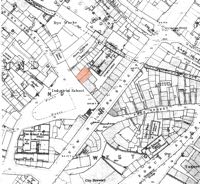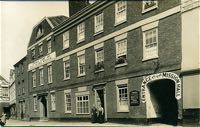
The Exeter Boys' Industrial School, Exe Island
Page added 11th June 2016
The 1857 Industrial School Act was intended to provide destitute and vagrant children residential care, and an industrial training, in a purpose run school. Two more acts extending and amending the regulations were introduced in 1860, and 1861. The Exeter Boys’ Industrial School was first proposed in 1862, by the Rev. F A Savile, of Barley House, when the good and the great were invited to subscribe to a fund to open a school for boys who were likely to fall into a life of crime. Suitable premises had been found in Exe Island and the H M Inspector of Industrial Schools, the Rev. Sydney Turner had agreed to inspect the building. The school would rely on both private funding and government aid.
Industrial Schools were considered the third step in education for the poor. The first was Ragged Schools, of which there were maybe three in Exeter, Reformatory Schools and then Industrial Schools.
The boys who were eligible for the Industrial School were selected from one of four categories.
1 Any child apparently under the age of 14 years, found begging or receiving alms, or being in any street, or public place for the purpose of begging or receiving alms.
2 Any child apparently under the age of 14 years, that is found wandering and not having any house or settled place of abode, any visible means of subsistence or frequents the company of reputed thieves.
3 Any child apparently under the age of 12 years, who, having committed an offence, punishable by imprisonment or some less punishment, ought nevertheless in the opinion of the justices, regard his age, and the circumstances of the case, to be sent to an industrial school.
4 Any child under the age of 14 years, whose parents represents that he is unable to control him, and that he desires such child to be sent to an industrial school, in pursuance of this act; and who at the same time give such undertakings or other security as may be approved by the justices before whom he is brought, in pursuance of this act, to pay all expenses incurred for the maintenance of such child at school, provided that no child who on being brought before the justice is proved to have been previously convicted of felony, shall be deemed to be within the provisions of this act.
The last category allowed parents who felt they had lost control of a boy, and who satisfied the criteria, to pay 2/6 per week for attendance. They were intended to remain at the school until they were 16, unless they joined the army or navy at 14.
The school building
The building, in Tudor Street was described as a former mansion that had been occupied by the poor. Having housed several tenants, it was in need of “repairs, paper, whitewash, and paint, (and) made to look a little more like its original self.” £300 had been raised to adapt and furnish the house into a school.
On the ground floor was the dining room, first floor was storage for holding stocks of blankets, sheets, shirts and towels, and on the second floor were the classrooms. Initially it would be able to take 12 boys, housing them in dormitories on the third floor. The beds were described as “iron bedsteads with very nice flock mattresses.”
A press report was concerned that the premises did not have a playground of any sort and that “The master of the school will be deprived of half his moral power over the boys for want of this "Uncovered schoolroom,” and of those humanising influences that spring up in a garden.” This was probably a factor for the school moving out of Exeter in 1869.
The boys would be taught a basic education that was expected from a Ragged School at that time, along with tailoring and shoemaking. The cellar had storage for wood that the boys would split and bundle up, using a binding machine, to be sold for fire lighting.
Mr and Mrs J W Curson were appointed as the master and matron in March 1863 and moved in to ready the premises as a school. On the 9 April 1863 the Government Inspector the Rev. Turner visited the premises and passed them as fit for purpose, gaining a certificate dated 7 May. On 21 April the Exeter Boys’ Industrial School opened, with one boy on the register.
A committee report in October, recorded that the register had increased to 14 boys, between the ages of 9 and 13. Two boys had been referred by a magistrate, the rest, apart from one, were partly funded by their parents, and the income they made by making small faggots for lighting fires, that sold for 4s per hundred. The last was a child of a German musician who had been referred by the Chaplain of the Devon and Exeter Hospital.
Other activities that the boys were taught were the already mentioned tailoring, supervised by master, and shoemaking taught by a warder who was a shoemaker by trade. Wire-working had also been added as a member of the committee had given the school an extensive order for their production. These activities all produced an income for the school, estimated to be £50 per year.
It was also estimated, at this early stage, that it would cost £300 per year to run the school, and that it had an income of £200, of fees and earnings, requiring fundraising to continue to make up the difference. At that time, the school was the only one of its type west of Bristol. It is interesting to note that committee members often referred to the boys as ‘young Arabs.’
A couple of cases.
TWO YOUNG ARABS.
Henry Blagden, 11 years of age, and John Howell, nine, where, at the request of their parents and with the sanction of the committee, sent to the Industrial School as two incorrigibles until they are 14 years old. Western Times 8 September 1863
BRINGING HIS MOTHER TO SHAME.–William John Lake, one of those juvenile outlaws who appear to be a greatly increasing community, had been picked up by a policeman about the city begging. He had parents, but they had no control over him, and as he came fairly within the limits of the Industrial Schools Act, he was committed to the excellent institution in Exe Ireland, established for the especial benefit of this class, “wrecked before they put to sea.” Western Times 10 November 1863
By August 1864, there were 20 boys on the register. The premises were enlarged and by 1867 there were 51 boys in residence. Other activities were added including knitting, making pegs and working in a ‘field garden.’
The school moves out
However, the inadequacy of the premises in Exe Island caught up with the school, and it was relocated on 7 August 1869 to the late 18th Century Church Stile House at Exminster. The extra space allowed an intake of up to 80 boys aged from 10 to 14 years.
The old Industrial School premises were purchased, along with eight dwellings at the rear by the Ewings Lane and Exe Island Mission in 1871.
Sources: The British Newspaper Archive, childrenshomes.org.uk, devon.gov.uk under school records, Wikipedia, historicengland.org.uk and an article entitled Industrial Schools in England, 1857-1933 by Gillian Carol Gear. Devon Family History Society Re: Collection 4517.
│ Top of Page │

